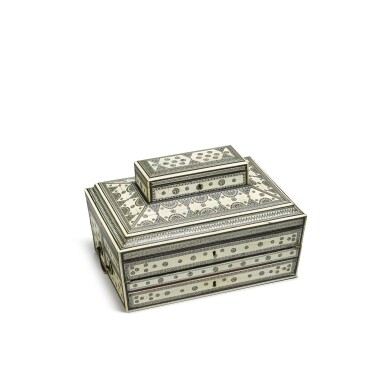
PROPERTY OF A LADY
A fine sadeli-ware work box, Western India, possibly Bombay, second half 19th century
Auction Closed
March 30, 12:47 PM GMT
Estimate
2,000 - 3,000 GBP
Lot Details
Description
of rectangular form, the exterior decorated with sadeli and ivory, with brass lock and carrying handles, a hinged opening to upper section revealing a letter holder, hinged section opening to reveal various compartments with lids, this section detachable, showing below compartments devoted to writing, a drawer, lacking keys
22 by 31.6 by 20cm.
Sadeli is a technique which consists of micromosaic made of wood, ivory and metal arranged in geometric patterns. This technique is usually associated with Western India, in particular with the Bombay Presidency (Bombay, Surat, Ahmedabad and Bilimora). The technique was known in other regions of India: in the catalogue of Bengal products sent to the Great Exhibition of 1851, some sadeli-wares are mentioned being made in Calcutta although "superior articles of the same description are made in Bombay" (Jaffer 2001, p.233).
Sandalwood was the preferred material used for such cases but due to its cost, often sadeli-decorated boxes "were constructed of a less expensive substrate with an inner lining and outer facing of sandalwood distinguishing the less expensive wood" (ibid, p.313); this is not the case for this refined work box, whose structure is entire made of sandalwood, emanating a delicate scent as soon as it is opened.
The bands of alternating semicircles and triangles which run along the lid are comparable to thosevon a workbox dated 1881, now in the Victoria & Albert Museum, London, inv. no.IS 2344-1883; published in Jaffer 2001, p.327, no.146, while the rows of small circles on the drawers are similar to those found on a portable writing desk dated to 1850-70, also in the Victoria & Albert Museum, London, inv. no.PEM:E23674, published in Jaffer 2001, p.317, no.129.
You May Also Like










